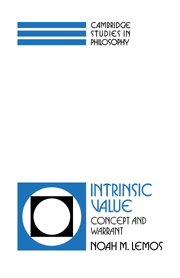Book contents
- Frontmatter
- Contents
- Preface
- Acknowledgments
- Part I Value, plurality, parts, and wholes
- 1 The concept of intrinsic value
- 2 The bearers of intrinsic value
- 3 Organic unities and the principle of universality
- 4 Higher goods and the myth of Tithonus
- 5 Pleasure and its intrinsic value
- 6 Consciousness, knowledge, and the consciousness thesis
- Part II Naturalism, nonnaturalism, and warrant
- Appendix A Chisholm's definition of organic unity
- Appendix B Some naturalistic analyses
- Selected bibliography
- Index
2 - The bearers of intrinsic value
Published online by Cambridge University Press: 07 May 2010
- Frontmatter
- Contents
- Preface
- Acknowledgments
- Part I Value, plurality, parts, and wholes
- 1 The concept of intrinsic value
- 2 The bearers of intrinsic value
- 3 Organic unities and the principle of universality
- 4 Higher goods and the myth of Tithonus
- 5 Pleasure and its intrinsic value
- 6 Consciousness, knowledge, and the consciousness thesis
- Part II Naturalism, nonnaturalism, and warrant
- Appendix A Chisholm's definition of organic unity
- Appendix B Some naturalistic analyses
- Selected bibliography
- Index
Summary
In this chapter, I consider what are the bearers of intrinsic value or what are the kinds of things that are intrinsically valuable. Are they abstract objects or concrete, particular things or both? If they are abstract objects, then are they properties, facts, or states of affairs? If they are particulars, are such things as persons, apples, and cars bearers of intrinsic value?
THE BEARERS OF VALUE: ABSTRACT OBJECTS
What are the bearers of intrinsic value? What are the kinds of things that have intrinsic value? Among the traditional candidates, we may distinguish between those that are abstract objects and those that are concrete, individual things such as persons, dogs, and cars. Let us begin by considering the former.
Concerning abstract objects, there are at least three main candidates: properties, states of affairs, and facts or states of affairs that obtain. Ordinary discourse sometimes suggests that properties are intrinsically good or bad. People sometimes say such things as “Pleasure and wisdom are intrinsically good” and “Pain is intrinsically bad.” The view that some properties are intrinsically good has been defended by Panayot Butchvarov. Some philosophers, including Chisholm, have held that states of affairs are the bearers of value. Others have held that facts are bearers of value. This view has been defended by W. D. Ross, who writes, “what is good or bad is always something properly expressed by a that-clause, i.e. an objective, or as I shall prefer to call it, a fact.” In this section, I defend the view that facts or states of affairs that obtain have intrinsic value, whereas properties and states of affairs that do not obtain do not have intrinsic value.
- Type
- Chapter
- Information
- Intrinsic ValueConcept and Warrant, pp. 20 - 31Publisher: Cambridge University PressPrint publication year: 1994



